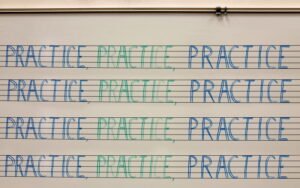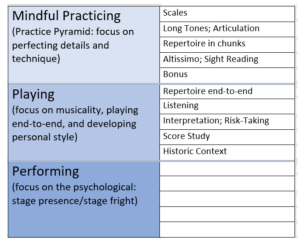You can’t go to work, you can’t go to rehearsals, so you have plenty of time to practice. Here are some tips for getting the most out of that extra practice time.
How long should I practice?
Well, not more than 2 hours a day, not less than 30 minutes a week. It all depends on how much time you have, what your goals are, and how effectively you use your practice time.
“If I don’t practice one day, I know it; two days, the critics know it; three days, the public knows it.” – Jascha Heifetz
Practicing regularly is more important than practicing longer. When I was a kid taking piano lessons, I was supposed to practice 30 minutes a day. In other words, three hours of practice for each weekly lesson. What I often did was skip the daily sessions, then try to do the whole three hours the day before my lesson. Needless to say, that didn’t work very well. Even if you don’t have time to practice every day, try to schedule regular sessions through the week. Some folks like to have off-days in their schedule. For example, practice Monday to Friday, with Saturday and Sunday off. Pick a time of day when you are mentally sharp. As a morning person, I like to practice early in the morning. Some research shows that having shorter morning and evening sessions rather than one long session improves learning speed.
Mindless practice can be worse than no practice at all
One example of mindless practice — a session where you do nothing but play a piece from beginning to end at performance tempo, then repeat over and over until your designated practice time is up. If you can play the whole thing at performance tempo without making mistakes you probably don’t need to practice it at all. But it’s more likely that you are actually practicing your mistakes, because you are not looking to identify and correct them. It’s not practice makes perfect, it’s practice makes permanent! So slow down and listen for things to improve — rhythm, notes, smoothness, intonation, dynamics, phrasing, etc.
Another example is the multitasking approach. Multitasking may be a great productivity boon in the workplace, but it not a good way to practice. Effective practice requires focusing 100% of your attention on analyzing what you are doing and how you can improve it. Put your phone on Do Not Disturb, turn off the TV, and concentrate. When you start to lose focus it’s a signal that you have practiced too long. Stop and take a break.
How much is too much? Not enough?
- You have practiced too long in a session when you start to lose focus,
- Or when your embouchure begins to leak air,
- Or when you are tired and stiff. You should feel refreshed, enlivened, and optimistic at the end of your session.
- According to The BulletProof Musician, there is little benefit from practicing more than 4 hours a day, and the point of diminishing returns is at about the 2 hour mark.
- It takes a certain amount of time to actually get in the groove. For me, that’s about 30 minutes. Also, the Pomodoro time management technique, suggests 25 minutes for a task, followed by a 5 minute break before going on to the next task.
- If you returning after a long layoff you may need to start with several 15-minute sessions per day rather than one long session.
How should I allocate my practice time?
This topic often starts with the question of how long you should warm up before going on to your band music or recital material. However, I like to look at a more big picture question first — the difference in mindset between three different kinds of practice:
Mindful Practice
The purpose is to improve. It is important to practice in small chunks, identify mistakes, and correct them immediately. Be self-critical. Demand perfection.
Playing
The purpose is musicality. Play the complete piece. Get into the mood of the piece. Don’t be self-critical; instead take risks to convey emotion. You might also throw in some listening to top performers and score study.
Performance
Coping with stage fright.
Mindful Practice and Playing are polar opposites in terms of mental approach. You should spend some time on both styles. There is more to music than pure technique but, at the same time, you need some minimum level of technique to support the musicality.
How to distribute your time across the three top-level phases depends on how much “performance” you do. Since I don’t do any live performing, and don’t have issues with stage fright, I probably should do something like 40 minutes mindful, 20 minutes playing in a 1 hour session. In reality, I don’t do enough playing.
Details like Scales and Long Tones fall under the Mindful Practice category. On that subject Jenny Maclay’s Practice Pyramid article says it all.
Plain English Practice Strategies
Have goals for your practice
I like to sit down every 3 months or so and assess my strengths and weaknesses. From that I identify a handful of things I want to work on in the near term. Not everything at once — that’s too overwhelming. Then I identify exercises to target these areas, spending maybe 5-10 minutes of my warm-up time on them. During that time I focus on playing those exercises perfectly, even if I have to play them at half speed, or even slower. Video recording is particularly useful for identifying problem areas. It’s amazing how much you can improve with only a few minutes of regular practice when you are looking and listening for ways to correct problems.
Another way to approach goals is to make a list of due dates, like lessons, performances, and auditions. Plan your practices to make sure you are not cramming your material at the last minute.
And, by the way, experts say goals should be written, specific, and measurable. I’m good about the measurable part, so-so the written part, and dreadful at the specific part. Do what I say, not what I do.
Practice what you don’t know
With a limited amount of practice time available, it’s important to prioritize how you use it. Focus on material that needs the most work. When I start learning a new piece, the first thing I do is play through it and divide it into short sections. Then I assign a difficulty to each section. I rank the sections from hard to easy and practice the hard ones first. As I practice them they get easier, and move down in the list. I also set a time limit for each section — maybe 5 minutes max — so I don’t practice any one section beyond the point of meaningful progress.
Finish on a high note
Not an altissimo note, but a psychological high point. Wind up your session with something you enjoy playing, and can play well. If you save your most difficult music for last, there’s a tendency to come away from the session with a sense of failure.
End each practice session with a period of reflection
What did you do well, and what needs more work? What did you learn? What should you focus on tomorrow?
Jargon Practice Techniques
Here are some practice approaches the have their roots in the science of performance psychology. You can read more about the psychology approach on the at the BulletProof Musician, Musician’s Way and Modacity blogs.
Spaced Repetition
Spaced repetition is the opposite of cramming. Instead of waiting until the night before the final exam, study the material regularly during the term, and review it periodically. There is a lot of complicated theory about “optimal” spacing, but here is a simple non-computerized system: Start by practicing a difficult section every day. As it begins to feel easier continue to practice it, but gradually reduce the frequency — every 2 days, then every 3 days, then weekly — until you have mastered it. Computerized flash card systems are based on spaced repetition theory.
Randomization
Randomization, like spaced repetition, is a way to encourage learning by disrupting familiar pattens. It is useful when you want to cover a large amount of material in a short time. It is better suited to short technical exercises or excerpts than for long lyrical pieces. Suppose you have an hour to practice 20 exercises. Number slips of paper from 1 to 20 and put them in a hat. Draw a number, and practice that exercise for a max of 5 minutes, or less if it feels easy. By the end of the hour you will have practiced at least 12 exercises. After a week you will have practiced everything 2-3 times. Randomization is particularly useful when you can prioritize your draw to favor more difficult exercises.
Deliberate Practice
Deliberate Practice is probably the single most transformative thing for me in improving my practice habits. The basic steps:
1. Identify one specific that you want to improve
2. Identify a strategy that might fix it
3. Test your strategy
4. Did the strategy work? If not, try another strategy. If it worked, document for future reference
Here is a video example from Marc Gelfo, the founder of Modacity.
Visualization
Visualization is the process of practicing in your imagination rather than with your instrument. Not only is this convenient when you are physically unable to practice, but it can reduce performance anxiety and enhance then musicality of your performance.
Further reading:
the critical importance of visualization in music practice
a 7 point how to guide for visualization
Strategies for Practicing Specific Problems
General
- When in doubt, Slow Down
- Or, if it’s a slow Adagio piece, when in doubt, Subdivide
Rhythm
- Use a metronome
- Clap the rhythm
- Tap your foot
- Subdivide
- Slow down
Smooth finger motion
- Vary the rhythm patterns
- Vary the articulation
- Play it backwards (literally)
- Work backward from the end — first master the last 4 notes, then the last 6, 8, etc.
- Slow down
Working up the tempo
- Sneak up on it: Start with metronome at half or less of performance tempo.. Play correctly 3 times in the row (or 5x or 7x). Bump up the metronome in 5 ticks and repeat. Continue until you get to performance tempo. Note: as a math person I do multiples of 5. Most real musicians seem to prefer multiples of 4.
- Two steps forward, one step back: Start slow. Play correctly 3x in a row. Bump up the metrome 10 ticks and play correctly once. Then back off by 5 ticks and play correctly 3x in a row. Continue until you get to performance tempo.
Working on Intonation
- Use a Drone
- Use a Tuner. Best bets are Tonal Energy Tuner and Tunable
Further Reading
- BulletProof Musician Blog
- Heany, “First Learn to Practice”
- Maclay, “The Musician’s Practice Pyramid“
- Modacity Blog
- MusiciansWay.com



Leave a Reply
You must be logged in to post a comment.